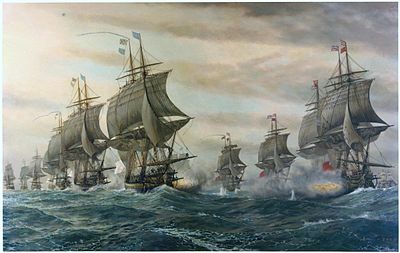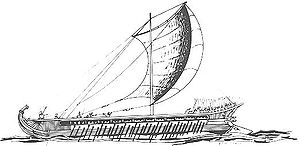- Naval warfare
-
"Sea power" redirects here. For the magazine, see Seapower.Lists
Portal Naval warfare is combat in and on seas, oceans, or any other major bodies of water such as large lakes and wide rivers.
Contents
History
Further information: Naval historyMankind has fought battles on the sea for more than 3,000 years. Land warfare would seem, initially, to be irrelevant and entirely removed from warfare on the open ocean, though this is not necessarily true. Land navigation, until the advent of extensive railroads was extremely dependent upon river systems and canals.
The latter were crucial in the development of the modern world in the United Kingdom, the Low Countries and northern Germany, for they enabled the bulk movement of goods and raw materials without which the Industrial Revolution would not have occurred. Prior to 1750, things moved by barge or sea, or not much at all. Thus armies, with their exorbitant needs for food, ammunition and fodder, were tied to the river valleys throughout the ages.
The oceanic influences throughout pre-recorded history (Homeric Legends, e.g. Troy), and classical works like the Odyssey underscore the past influences. The Persian Empire — united and strong — couldn't prevail against the might of the Athenian fleet combined with that of lesser city states in several attempts to conquer the Greek city states. Phoenicia's and Egypt's power, Carthage's and even Rome's depended in no mean way upon control of the seas.
So too did the Venetian Republic dominate Italy's city states, thwart the Ottoman Empire, and dominate commerce on the Silk Road and the Mediterranean in general for centuries. For three centuries, the Northmen commonly called the Vikings raided and pillaged and went where they willed, far into central Russia and the Ukraine, and even to far off Constantinople (both via the Black Sea tributaries and through the Strait of Gibraltar).
Many sea battles through history also provide a reliable source of shipwrecks for underwater archaeology. A major example, albeit not very commonly known, is the exploration of the wrecks of various warships in the Pacific Ocean.
Oars people of the Mediterranean Sea
The first dateable recorded sea battle occurred about 1210 BC: Suppiluliuma II, king of the Hittites, defeated a fleet from Cyprus, and burned their ships at sea.
Assyrian reliefs from the 8th century BC show Phoenician fighting ships, with two levels of oars, fighting men on a sort of bridge or deck above the oarsmen, and some sort of ram protruding from the bow. No written mention of strategy or tactics seems to have survived.
Josephus Flavius (Antiquities IX 283-287) reports a naval battle between Tyre and the king of Assyria who was aided by the other cities in Phoenicia. The battle took place off the shores of Tyre. Although the Tyrian fleet was much smaller in size, the Tyrians defeated their enemies.
The Greeks of Homer just used their ships as transport for land armies, but in 664 BC there is a mention of a battle at sea between Corinth and its colony city Corcyra.
The Persian Wars were the first to feature large-scale naval operations, not just sophisticated fleet engagements with dozens of triremes on each side, but combined land-sea operations. It seems unlikely that all this was the product of a single mind or even of a generation; most likely the period of evolution and experimentation was simply not recorded by history.
After some initial battles while subjugating the Greeks of the Ionian coast, the Persians determined to invade Greece proper. Themistocles of Athens estimated that the Greeks would be outnumbered by the Persians on land, but that Athens could protect itself by building a fleet (the famous "wooden walls"), using the profits of the silver mines at Laurium to finance them.
The first Persian campaign, in 492 BC, was aborted because the fleet was lost in a storm, but the second, in 490 BC, captured islands in the Aegean Sea before landing on the mainland near Marathon. Attacks by the Greek armies repulsed these.
The third Persian campaign, under Xerxes I of Persia ten years later (480 BC), followed the pattern of the first in marching the army via the Hellespont while the fleet paralleled them offshore. Near Artemisium, in the narrow channel between the mainland and Euboea, the Greek fleet held off multiple assaults by the Persians, the Persians breaking through a first line, but then being flanked by the second line of ships. But the defeat on land at Thermopylae forced a Greek withdrawal, and Athens evacuated its population to nearby Salamis Island. Aeschylus wrote a play about the defeat, called The Persians, which was performed at a Greek theatre contest a few years after the battle. It is the oldest known surviving play.
The ensuing Battle of Salamis was one of the decisive engagements of history. Themistocles trapped the Persians in a channel too narrow for them to bring their greater numbers to bear, and attacked them vigorously, in the end causing the loss of 200 Persian ships vs 40 Greek. At the end, Xerxes still had a fleet stronger than the Greeks, but withdrew anyway, and after losing at Plataea in the following year, returned to Asia Minor, leaving the Greeks their freedom. Nevertheless, the Athenians and Spartans attacked and burned the laid-up Persian fleet at Mycale, and freed many of the Ionian towns.
During the next fifty years, the Greeks commanded the Aegean, but not harmoniously. After several minor wars about which we know little, tensions exploded into the Peloponnesian War (431 BC) between Athens' Delian League and the Spartan Peloponnese. Naval strategy was critical; Athens walled itself off from the rest of Greece, leaving only the port at Piraeus open, and trusting in its navy to keep supplies flowing while the Spartan army besieged it. This strategy worked, although the close quarters likely contributed to the plague that killed many Athenians in 429.
There were a number of sea battles between galleys; at Rhium, Naupactus, Pylos, Syracuse, Cynossema, Cyzicus, Notium. But the end came for Athens in 405 at Aegospotami in the Hellespont, where the Athenians had drawn up their fleet on the beach, and were surprised by the Spartan fleet, who landed and burned all the ships. Athens surrendered to Sparta in the following year.
Navies next played a major role in the complicated wars of the successors of Alexander the Great.
The Roman Republic had never been much of a seafaring nation, but it had to learn, and learn fast. In the Punic Wars with Carthage, Romans developed the technique of grappling and boarding enemy ships with soldiers. The Roman Navy grew gradually as Rome found itself involved in more and more Mediterranean politics; by the time of the Roman Civil War and the Battle of Actium in 31 BC, hundreds of ships were involved, many of them quinqueremes mounting catapults and fighting towers. Following the Emperor Augustus transforming the Republic into the Roman Empire, Rome gained control of most of the Mediterranean. Without any significant maritime enemies, the Roman navy was reduced mostly to patrolling for pirates and transportation duties. It was only on the fringes of the Empire, in newly gained provincies or defensive missions against barbarian invasion, did the navy still engage in actual warfare.
Ancient China
Main article: Naval history of ChinaIn ancient China, the first known naval battles took place during the Warring States (481 BC - 221 BC), a period where regional kings battled against one another. Chinese naval warfare in this ancient period featured grapple-and-hook, as well as ramming tactics with ships called "stomach strikers" and "colliding swoopers".[1] It was written in the subsequent Han Dynasty that the Warring States era Chinese had employed ge chuan ships (dagger-axe ships, or halberd ships), thought to have a simple description of a ship manned by marines carrying dagger-axe halberds as personal weapons.
The later 3rd century Three Kingdoms era Chinese writer Zhang Yan asserted in his writing that the Warring States Chinese named the boats this way because halberd blades were actually fixed and attached to the hull of the ship in order to rip into the hull of another ship while ramming, to stab enemies in the water that had fallen overboard and were swimming, or simply to clear any possible dangerous marine animals in the path of the ship (since the ancient Chinese did believe in sea monsters, see Xu Fu for more info).
Qin Shi Huang, the first emperor of the Qin Dynasty (221 BC - 207 BC), owed much of his success in unifying China (specifically southern China) to naval power, although an official navy was not yet established (see Medieval Asia section below). Zhou Dynasty era Chinese were known to use temporary pontoon bridges for general means of transportation, but it was during the Qin and later Han Dynasty that large permanent pontoon bridges were assembled, and used for purposes of warfare (first written account of a pontoon bridge in the West being the oversight of the Greek Mandrocles of Samos in aiding a military campaign of Persian Emperor Darius I over the Bosporus).
During the Han Dynasty (202 BC - AD 220), the Chinese discovered the use of the stern-mounted steering rudder, as well as designed a new ship type, the junk. During the late Han Dynasty into the Three Kingdoms period, significantly large naval battles like the Battle of Chibi marked the advancement of naval warfare in the East. In the latter engagement, the Chinese military strategist Zhuge Liang from the Kingdom of Shu is well known for his fire attack upon the massive naval fleet of Prime Minister Cao Cao.
In terms of seafaring abroad, arguably one of the first Chinese to sail into the Indian Ocean and to reach Sri Lanka and India by sea was the Buddhist monk Fa Xian in the early 5th century (although diplomatic ties and land trade to Persia and India was established during the earlier Han Dynasty). However, Chinese naval maritime influence would not present itself in the Indian Ocean until the medieval period.
Europe, Middle East and North Africa
While most of the barbarian invasions of the 4th century and later mostly occurred by land, some notable examples of naval conflicts can be highlighted. In the late 3rd Century, in the reign of Emperor Gallienus, a large raiding party, composed by Goths, Gepids and Heruli, launched itself in the Black Sea, raiding the coast of Anatolia and Thrace, and crossing into the Aegean Sea, plundering mainland Greece (including Athens and Sparta) and going as far as Crete and Rhodes. In the twilight of the Empire in the late 4th Century, examples include that of Emperor Majorian, who, with the help of Constantinople, mustered a large fleet in a failed effort to expel the Germanic invaders from their recently conquered African territories, and a defeat of an Ostrogothic fleet at Sena Gallica in the Adriatic Sea.
During the Muslim conquests of the 7th century, Arab fleets begin to make an appearance, raiding Sicily in 652 (see History of Islam in southern Italy and Emirate of Sicily), and defeating the Byzantine Navy in 655. Constantinople is saved from a prolonged Arab siege in 678 by the invention of Greek fire, an early form of flamethrower that was devastating to the ships in the besieging fleet. These were just the first of many encounters during the Byzantine-Arab Wars.
The Islamic Caliphate, or Arab Empire, became the dominant naval power in the Mediterranean Sea from the 7th to 13th centuries, during what is known as the Islamic Golden Age. One of the most significant inventions in medieval naval warfare was the torpedo, invented in Syria by the Arab inventor Hasan al-Rammah in 1275. His torpedo ran on water with a rocket system filled with explosive gunpowder materials and had three firing points. It was a very effective weapon against ships.[2]
In the 8th century the Norse Vikings begin to make an appearance, although their usual style is to appear quickly, plunder, and disappear, preferably undefended locations. King Alfred the Great of England built a fleet and was able to stay the Viking incursions, establishing the boundaries of Danelaw in a 884 treaty.
The Norse also fought several sea battles among themselves. This was normally done by binding the ships on each side together, thus essentially fighting a land battle on the sea. However the fact that the losing side could not easily escape meant that battles tended to be hard and bloody. The Battle of Svolder is perhaps the most famous of these battles.
As Arab power in the Mediterranean began to wane, the Italian trading towns of Genoa, Pisa, and Venice stepped in to seize the opportunity, setting up commercial networks and building navies to protect them. At first the navies fought with the Arabs (off Bari in 1004, at Messina in 1005), but then they found themselves contending with Normans moving into Sicily, and finally with each other. The Genoese and Venetians fought four naval wars, in 1253–1284, 1293–1299, 1350–1355, and 1378–1381. The last ended with a decisive victory for Venice, which gave them almost a century to enjoy Mediterranean trade domination before other European countries started exploring to the south and west.
In the north of Europe, the near-continuous conflict between England and France was characterised by a number of raids on coastal towns and ports along each other coastlines and the securing of sea lanes to protect transports carrying troops from England to France. The Battle of Dover in 1217, between a French fleet of 80 ships under Eustace the Monk and an English fleet of 40 under Hubert de Burgh, is notable as the first recorded battle using sailing ship tactics. The battle of Arnemuiden (23 September 1338), which resulted in a French victory, marked the opening of the Hundred Years War and was the first battle involving artillery.[3] However the battle of Sluys, fought two years later, saw the destruction of the French fleet in a decisive action which allowed the English effective control of the sea lanes and the strategic initiative for much of the war.
East and South Asia
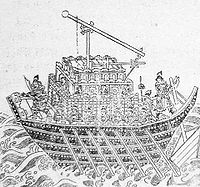 A Chinese Song Dynasty naval river ship with a Xuanfeng traction-trebuchet catapult on its top deck, taken from an illustration of the Wujing Zongyao (1044)
A Chinese Song Dynasty naval river ship with a Xuanfeng traction-trebuchet catapult on its top deck, taken from an illustration of the Wujing Zongyao (1044)
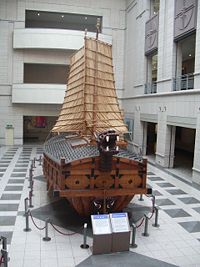 A replica of Korean Turtle ship.
A replica of Korean Turtle ship.
The Sui Dynasty (581 - 618) and Tang Dynasty (618 - 907) of China were involved in several naval affairs over the triple-set of polities ruling medieval Korea (Three Kingdoms of Korea), along with engaging naval bombardments on the peninsula from Asuka period Yamato Kingdom (Japan). A prominent factor in the sudden decline and collapse of the Sui Dynasty was its pouring of state funds into the Goguryeo-Sui Wars, where the Chinese assembled an enormous naval fleet that in the end was unsuccessful.
The succeeding Tang Dynasty of Europe took on a different foreign policy, aiding the Silla Dynasty (see also Unified Silla) in expelling the armies and naval forces of the Japanese (see Battle of Baekgang) and conquering Silla's other Korean rivals, Baekje and Goguryeo by 668. In addition, the Chinese Tang Dynasty had maritime trading, tributary, and diplomatic ties as far as modern-day Sri Lanka, India, Islamic Iran and Arabia, as well as Somalia in East Africa.
From the Axumite Kingdom in modern-day Ethiopia, the Arab traveller Sa'd ibn Abi-Waqqas sailed from there to Tang China during the reign of Emperor Gaozong. Two decades later, he returned with a copy of the Quran, establishing the first Islamic mosque in China, the Mosque of Remembrance in Guangzhou. What followed was a rising rivalry between Arab and Chinese for dominant control of sea lanes of trade in the Indian Ocean. In his book Cultural Flow Between China and the Outside World, Shen Fuwei notes that maritime Chinese merchants in the 9th century were landing regularly at Sufala in East Africa to cut out Arab middle-men traders.[4]
The Chola Dynasty of medieval India was a dominant seapower in the Indian Ocean, an avid maritime trader and diplomatic entity with Song China. Rajaraja Chola I (reigned 985 to 1014) and his son Rajendra Chola I (reigned 1014–42), who were from the Dravidian kingdom in southern India, sent out a great naval expedition that occupied parts of Myanmar, Malaya, and Sumatra. While many believe the Cholas were the first rulers noted to have a naval fleet in the Indian subcontinent, there are at least two evidences to cite use of navies. Narasimhavarman Pallava I transported his troops to Sri Lanka to help Manavarman to reclaim the throne. Shatavahanahas were known to possess a navy that was widely deployed to influence Southeast Asia. What is not known is the extent of use.
Some argue that there is no evidence to support naval warfare in a contemporary sense. Others say that ships routinely carried bands of pirates to keep pirates at bay. However, since the Arabs were known to use catapults, naptha, and devices attached to ships to prevent boarding parties, one can reasonably conclude that Chola navies not only transported troops but also provided support, protection, and attack capabilities against enemy targets.
In the 12th century, China's first permanent standing navy was established by the Southern Song Dynasty, the headquarters of the Admiralty stationed at Ding-hai. This came about after the conquest of northern China by the Jurchen people (see Jin Dynasty) in 1127, while the Chinese court fled south from Kaifeng to Hangzhou. Equipped with the magnetic compass and knowledge of Shen Kuo's famous treatise (on the concept of true north), the Chinese became proficient experts of navigation in their day. They raised their naval strength from a mere 11 squadrons of 3,000 marines to 20 squadrons of 52,000 marines in a century's time.
Employing paddle wheel crafts and trebuchet's throwing gunpowder bombs from the decks of their ships, the Chinese became a formidable foe to the Jin Dynasty during the 12th-13th centuries (see also Battle of Caishi and Battle of Tangdao). With a powerful navy, China dominated maritime trade throughout South East Asia as well. Until 1279, the Chinese were able to use their naval power to defend against the Jin to the north, until the Mongols finally conquered all of China. After the Song Dynasty, the Mongol-led Yuan Dynasty of China was a powerful maritime force in the Indian Ocean.
The Yuan Emperor Kublai Khan attempted to invade Japan twice with enormous fleets (of both Mongols and Chinese), in 1274 and again in 1281, both attempts being unsuccessful (see Mongol invasions of Japan). Building upon the technological achievements of the earlier Chinese Song Dynasty, the Mongols also employed early cannons upon the decks of their ships.
While the Chinese Song Dynasty built its naval strength, the Japanese also had considerable naval prowess. The strength of Japanese naval forces could be seen in the Genpei War, in the large-scale Battle of Dan-no-ura on April 25, 1185. The forces of Minamoto no Yoshitsune were 850 ships strong, while Taira no Munemori had 500 ships under his command.
In the mid-14th century, the rebel leader Zhu Yuanzhang (1328–1398) seized power in the south amongst many other rebel groups. His early success was owed to the aid of capable officials such as Liu Ji and Jiao Yu, and their gunpowder weapons (see Huolongjing). Yet the decisive battle that cemented his success and his founding of the Ming Dynasty (1368–1644) was the Battle of Lake Poyang, considered one of the largest naval battles in history.
In the 15th century, the Chinese Ming Dynasty Admiral Zheng He was assigned to assemble a massive fleet for several tributary missions abroad, sailing throughout the waters of the South East Pacific and the Indian Ocean. During his maritime missions, on several occasions Zheng's fleet came into conflict with pirates. Zheng's fleet also became involved in a conflict in Sri Lanka, where the King of Ceylon traveled back to Ming China afterwards to make a formal apology to the Emperor.
In the late 16th century, Toyotomi Hideyoshi of Momoyama-era Japan gathered an enormous fleet to assault the Joseon Dynasty of Korea when the Korean King Seonjo refused to allow Japanese armies to invade Ming Dynasty China via the Korean Peninsula as a staging ground. During the Japanese invasions of Korea (1592-1598), the Japanese employed clever close-range tactics on land with arquebus rifles, but also relied upon close-range firing of muskets in grapple-and-board style naval engagements.
The Japanese were successful in first capturing the Korean port at Busan, the capital at Hanseong (In modern-day Seoul) fell to their forces, and then proceeded to move far north into the Korean peninsula. The Chinese emperor Wanli Emperor sent military forces to the Korean peninsula. And, The resistance of Korean assisted a Chinese army[5].
Eventually the farther firing range of Korean cannons, along with the brilliant naval strategies of the Korean Admiral Yi Sun-sin became the main detrimental factors in ultimate Japanese defeat. Admiral Yi is credited Turtle ship (Geobukseon). Turtle Ships were used mostly to spearhead attacks. They were best used in tight areas and around islands rather than the open sea. Admiral Yi effectively cut off the possible Japanese supply line that would have run through the Yellow Sea to China, as well as severely weakened the Japanese strength and fighting morale in several heated engagements (where many regard the most critical Japanese defeat to be the Battle of Hansan Island).
The Ming Dynasty Imperial Navy defeated a Portuguese navy led by Martim Affonso in 1522. The Chinese destroyed one vessel by targeting its gunpowder magazine, and captured another Portuguese ship.[6][7]
A Ming army and Navy led by Koxinga defeated a western power, the Dutch East India Company at the Siege of Fort Zeelandia, the first time China had engaged against a western power and won.[8] The Chinese used cannons and ships to bombard the Dutch into surrendering.[9][10]
Sails and empires
- Main article: Age of sail
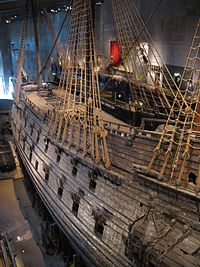 The early 17th century galleon Vasa. on display at the Vasa Museum in Stockholm. Vasa, with its high stern castle and double battery decks, was a transitional design between the preferences for boarding tactics and the line of battle.
The early 17th century galleon Vasa. on display at the Vasa Museum in Stockholm. Vasa, with its high stern castle and double battery decks, was a transitional design between the preferences for boarding tactics and the line of battle.
The late Middle Ages was important as the time of the development of the cogs, caravels and carracks ships capable of surviving the tough conditions of the open ocean, with enough backup systems and crew expertise to make long voyages routine. In addition, they grew from 100 tons to 300 tons displacement, enough to carry cannons as armament and still have space left over for profitable cargo. One of the largest ships of the time, the Great Harry displaced over 1,500 tons.
The voyages of discovery were fundamentally commercial rather than military in nature, although the line was sometimes blurry in that a country's ruler was not above funding exploration for personal profit, nor was it a problem to use military power to enhance that profit. Later the lines gradually separated, in that the ruler's motivation in using the navy was to protect private enterprise so that they could pay more taxes.
Like the Egyptian Shia-Fatimids and Mamluks, the Sunni-Islamic Ottoman Empire centered in modern-day Turkey dominated the eastern Mediterranean Sea. The Ottomans built a powerful navy, rivaling the Italian city-state of Venice during the Ottoman-Venetian Wars (1499-1503).
Although they were sorely defeated in the Battle of Lepanto (1571) by the Holy League, the Ottomans quickly rebuilt their naval strength, and afterwards successfully defended the island of Cyprus so that it would stay in Ottoman hands. However, with the concurrent Age of Discovery, Europe had far surpassed the Ottoman Empire, and successfully bypassed their reliance on land-trade by discovering maritime routes around Africa and towards the Americas.
The first naval action in defense of the new colonies was just ten years after Vasco da Gama's epochal landing in India. In March 1508, a combined Gujarati/Egyptian force surprised a Portuguese squadron at Chaul, and only two Portuguese ships escaped. The following February, the Portuguese viceroy destroyed the allied fleet at Battle of Diu, thus confirming Portuguese domination of the Indian Ocean.
In 1582, the Battle of Ponta Delgada in the Azores, in which a Spanish fleet defeated a combined Portuguese, French, and English force, thus ending the Portuguese succession crisis, was the first battle fought in mid-Atlantic.
In 1588, Philip II of Spain sent his Spanish Armada to subdue Elizabeth I of England, but Admiral Sir Charles Howard forced its retreat, beginning the rise to prominence of the Royal Navy. However it was unable to follow up with a decisive blow against the Spanish navy, which remained the most important for another half century. After the war's end in 1604 the English fleet went through a time of relative neglect and decline.
In the 16th century, the Barbary states of North Africa rose to power and they collectively became a dominant naval power in the Mediterranean Sea due to the Barbary pirates. The coastal villages and towns of Italy, Spain and Mediterranean islands were frequently attacked by them and long stretches of the Italian and Spanish coasts were almost completely abandoned by their inhabitants; after 1600 Barbary pirates occasionally entered the Atlantic and struck as far north as Iceland.
According to Robert Davis[11][12] between 1 million and 1.25 million Europeans were captured by Barbary pirates and sold as slaves in North Africa and the Ottoman Empire between the 16th and 19th centuries. These slaves were captured mainly from seaside villages in Italy, Spain and Portugal, and from farther places like France, England, the Netherlands, Ireland and even Iceland and North America. The Barbary pirates were also able to successfully defeat and capture many European ships, which was largely due to advances in sailing technology by the Barbary states. The earliest naval trawler, xebec and windward ships were employed by the Barbary pirates from the 16th century.[13]
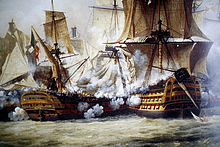 The 1805 Battle of Trafalgar.
The 1805 Battle of Trafalgar.
From the middle of the 17th century competition between the expanding English and Dutch commercial fleets came to a head in the Anglo-Dutch Wars, the first wars to be conducted entirely at sea. Most memorable of these battles was the raid on the Medway, in which the Dutch admiral Michiel de Ruyter sailed up the river Thames, and destroyed most of the British fleet. This remains to date the greatest naval defeat of England and her consecutive countries, and established Dutch supremacy at sea for over half a century. The English and Dutch wars were also known for very few ships being sunk, as it was very difficult to hit ships below the water level; the water surface deflected cannon balls, and the few holes produced could be patched quickly. Naval forces were severely weakened by casualties to the men and damage to the sails more than by loss of ships.
The 18th century developed into a period of seemingly continuous world wars, each larger than the last. At sea, the British and French were bitter rivals; the French aided the fledgling United States in the American Revolutionary War, but their strategic purpose was to capture territory in India and the West Indies--which they did not achieve. In the Baltic Sea, the final attempt to revive the Swedish Empire led to Gustav III's Russian War, with its grande finale at the Second Battle of Svensksund. The battle was unrivalled in size until the 20th century, was a decisive Swedish tactical victory but its strategical result was poor (due to poor army performance and previous lack of initiative from the Swedes) and the war ended without any territorial changes.
Even the change of government due to the French Revolution seemed to intensify rather than diminish the rivalry, and the Napoleonic Wars included a series of legendary naval battles, culminating in the Battle of Trafalgar in 1805, by which Admiral Horatio Nelson broke the power of the French and Spanish fleets, but lost his own life in so doing.
From wood and wind to steel and steam
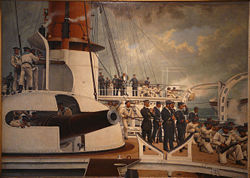 The French ironclad Vauban (1882-1905)
The French ironclad Vauban (1882-1905)
Trafalgar ushered in the Pax Britannica of the 19th century, marked by general peace in the world's oceans, under the ensigns of the Royal Navy. But the period was one of intensive experimentation with new technology; steam power for ships appeared in the 1810s, improved metallurgy and machining technique produced larger and deadlier guns, and the development of explosive shells, capable of demolishing a wooden ship at a single blow, in turn required the addition of iron armour.
Although naval power during the Song, Yuan, and Ming dynasties established China as a major world seapower in the East, the Qing Dynasty lacked an official standing navy. They were more interested in pouring funds into military ventures closer to home (China proper), such as Mongolia, Tibet, and Central Asia (modern Xinjiang). However, there were some considerable naval conflicts during the Qing Dynasty before the First Opium War (such as the Battle of Penghu, or the conflict against Koxinga).
The insignificant naval effort that the Manchus/Chinese pitted against the more advanced British steam-powered ships during the first of the Opium Wars in the 1840s was sorely defeated. This left China open to virtual foreign domination (from European powers and then Japan) via spheres of influence over regions of China for economic gain. Although the Qing Dynasty attempted to modernize the Chinese navy, China's Beiyang Fleet was dealt a severe blow by the Imperial Japanese Navy in the First Sino-Japanese War (1894–1895).
The famous battle of the CSS Virginia and USS Monitor in the American Civil War was the duel of ironclads that symbolized the changing times. The first fleet action between ironclad ships was fought in 1866 at the Battle of Lissa between the navies of Austria and Italy. Because the decisive moment of the battle occurred when the Austrian flagship the Erzherzog Ferdinand Max successfully sank the Italian flagship Re d'Italia by ramming, in subsequent decade every navy in the world largely focused on ramming as the main tactic. The last known use of ram in naval battle was in 1879 when the Peruvian ship Huáscar rammed the Chilean ship Esmeralda. The last known gunboat that was equipped with a ram was launched in 1908 - the German ship SMS Emden.
As the century came to a close, the familiar modern battleship began to emerge; a steel-armored ship, entirely dependent on steam, and sporting a number of large shell guns mounted in turrets arranged along the centerline of the main deck. The ultimate design was reached in 1906 with the HMS Dreadnought which entirely dispensed with smaller guns, her main guns being sufficient to sink any existing ship of the time.
 The US ships of the Great White Fleet in 1907.
The US ships of the Great White Fleet in 1907.
The Russo-Japanese War and particularly the Battle of Tsushima in 1905 was the first test of the new concepts, resulting a stunning Japanese victory and the destruction of most Russian ships.
With the advent of the steamship, it became possible to create massive gun platforms and to provide them with heavy armor protection. The Dreadnought battleships and their successors were the first capital ships that combined technology and firepower with a mobile platform. However, in the first half of the 20th century, the utility of air power in support of the fleet began to emerge;
World War I pitted the old Royal Navy against the new navy of Imperial Germany, culminating in the 1916 Battle of Jutland. The future was heralded when the seaplane carrier HMS Engadine and her Short 184 seaplanes joined the battle. Meanwhile, in the Black Sea, Russian seaplanes flying from a fleet of converted carriers interdicted Turkish maritime supply routes, Allied air patrols began to counter German U-Boat activity in Britain's coastal waters, and a British Short 184 carried out the first successful torpedo attack on a ship.
In 1918 the Royal Navy converted an Italian liner to create the first aircraft carrier, HMS Argus, and shortly after the war the first purpose-built carrier, HMS Hermes was launched. Many nations agreed to the Washington Naval Treaty and scrapped many of their battleships and cruisers while still in the shipyards, but the growing tensions of the 1930s restarted the building programs, with even larger ships than before; IJN Yamato, the largest battleship ever, displaced 72,000 tons and mounted 18.1-inch (460 mm) guns.
Above and below the surface
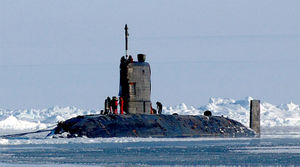 HMS Tireless. Nuclear submarines proved to be very successful during the Falklands War when HMS Conqueror sank ARA Belgrano with ease.
HMS Tireless. Nuclear submarines proved to be very successful during the Falklands War when HMS Conqueror sank ARA Belgrano with ease.
The victory of the Royal Navy at the Battle of Taranto was a pivotal point as this was the first true demonstration of naval air power. Following 7 December 1941 when the United States came into World War II, the sinking of HMS Prince of Wales and HMS Repulse marked the end of the era of the battleship, and the new importance of aircraft and their transportation, the aircraft carrier, came to the fore.
During the Pacific War, battleships and cruisers spent most of their time bombarding shore positions, while the carriers were the stars of the key Battle of the Coral Sea, Battle of Midway, Battle of the Philippine Sea, and the climactic Battle of Leyte Gulf. Air power remained key to navies throughout the 20th century, moving to jets launched from ever-larger carriers, and augmented by cruisers armed with guided missiles and cruise missiles.
Roughly parallel to the development of naval aviation was the development of submarines to travel underneath the sea, at first for short dives, then later to be able to spend weeks or months underwater powered by a nuclear reactor. In both World Wars, submarines (U-boats in Germany) primarily exerted their power by using torpedoes to sink merchant ships, as well as other warships. In the 1950s the Cold War inspired the development of ballistic missile submarines, each one loaded with dozens of nuclear-armed missiles and with orders to launch them from sea should the other nation attack.
Against the backdrop of these developments, World War II had seen the United States become by far the largest Naval power in the world. Throughout the rest of the 20th century The United States Navy would maintain a tonnage greater than that of the next 17 largest navies combined.[14]
The only major naval conflict that has taken place since World War II is the 1982 Falklands War, between Argentina and the United Kingdom. A Royal Navy task force of approximately 100 ships was dispatched over 7000 miles from the British mainland to the South Atlantic. The British were heavily outnumbered in airpower with only 36 Harriers from their two aircraft carriers, compared with at least 200 aircraft of the Fuerza Aérea Argentina. Most of the land-based aircraft of the Royal Air Force were not available due to the distance from air bases. This reliance on aircraft at sea showed the importance of the unique ability of the aircraft carrier. The Falklands showed the vulnerability of modern ships to sea-skimming missiles like the Exocet. One hit from an Exocet sank HMS Sheffield, a modern anti-air warfare destroyer. Important lessons about ship design, damage control and ship construction materials were learnt from the conflict.
The Falklands War was a unique conflict and at the present time, large naval wars seem to be seldom seen affairs as modern day warfare seemingly evolves further from warships, which have existed for centuries, to reliance on new technologies such as military aircraft and land warfare. The main function of the modern navy being to exploit its control of the seaways to project power ashore. Power projection has been the primary naval feature of conflicts like the Korean War, Suez Crisis, Vietnam War, Konfrontasi, Gulf War, Kosovo War, the War on Terrorism in Afghanistan and the Iraq War.
-
USS Theodore Roosevelt launching an F-14 Tomcat, while F/A-18 Hornets wait to take off during Kosovo War.
-
HMAS Sydney in the Persian Gulf in 1991.
Main articles: Naval history and Maritime history- Hellenic Navy
- History of the Indian Navy
- Ottoman Navy
- History of the Royal Navy
- History of the United States Navy
- Naval history of China
- Naval history of Japan
- Naval history of Korea
- Naval history of the Netherlands
- Spanish Navy
- Roman Navy
- Byzantine Navy
- Portuguese Navy
- Naumachia
- Sir Julian Corbett and Rear Admiral Alfred Thayer Mahan, major theorists.
See also
Lists:
Notes
- ^ Needham, Volume 4, Part 3, 678.
- ^ Ancient Discoveries, Episode 12: Machines of the East. History Channel. http://www.youtube.com/watch?v=0R3ZbzhRp_k. Retrieved 2008-09-08
- ^ Jean-Claude Castex, Dictionnaire des batailles navales franco-anglaises, Presses de l'Université Laval, 2004, p.21
- ^ Shen, 155.
- ^ Japan encyclopedia By Louis Frédéric (Page 92) [1]
- ^ Royal Asiatic Society of Great Britain and Ireland. China Branch (1895). Journal of the China Branch of the Royal Asiatic Society for the year ..., Volumes 27-28. SHANGHAI: The Branch. p. 44. http://books.google.com/?id=faNDAAAAYAAJ&pg=PA44&dq=the+chinese+emboldened+by+this+military+success+strangers+attack+portuguese&q=the%20chinese%20emboldened%20by%20this%20military%20success%20strangers%20attack%20portuguese. Retrieved 2010-06-28.(Original from Princeton University)
- ^ Royal Asiatic Society of Great Britain and Ireland. North-China Branch (1894). Journal of the North-China Branch of the Royal Asiatic Society, Volumes 26-27. SHANGHAI: The Branch. p. 44. http://books.google.com/?id=zKRBAAAAYAAJ&pg=RA2-PA44&dq=the+chinese+emboldened+by+this+military+success+strangers+attack+portuguese&q=the%20chinese%20emboldened%20by%20this%20military%20success%20strangers%20attack%20portuguese. Retrieved 2010-06-28.(Original from Harvard University)
- ^ Donald F. Lach, Edwin J. Van Kley (1998). Asia in the Making of Europe: A Century of Advance : East Asia. University of Chicago Press. p. 752. ISBN 0226467694. http://books.google.com/?id=W0fBhqb1kdkC&pg=PA1821&dq=koxinga+cannon+dutch&q=koxinga%20cannon%20dutch. Retrieved 2010-06-28.
- ^ Andrade, Tonio. "How Taiwan Became Chinese Dutch, Spanish, and Han Colonization in the Seventeenth Century Chapter 11 The Fall of Dutch Taiwan". Columbia University Press. http://www.gutenberg-e.org/andrade/andrade11.html#txt98. Retrieved 2010-06-28.
- ^ Lynn A. Struve (1998). Voices from the Ming-Qing cataclysm: China in tigers' jaws. Yale University Press. p. 312. ISBN 0300075537. http://books.google.com/?id=cRXAcZGcpa8C&pg=PA232&dq=koxinga+bombard+dutch&q=koxinga%20bombard%20dutch. Retrieved 2010-06-28.
- ^ "When Europeans were slaves: Research suggests white slavery was much more common than previously believed". http://researchnews.osu.edu/archive/whtslav.htm.
- ^ Davis, Robert. Christian Slaves, Muslim Masters: White Slavery in the Mediterranean, the Barbary Coast and Italy, 1500-1800.[2]
- ^ Simon de Bruxelles (28 February 2007). "Pirates who got away with it by sailing closer to the wind". The Times. http://www.timesonline.co.uk/tol/news/world/africa/article1449736.ece. Retrieved 2008-09-10.
- ^ Work, Robert O. "Winning the Race:A Naval Fleet Platform Architecture for Enduring Maritime Supremacy". Center for Strategic and Budgetary Assessments Online. Retrieved April 8, 2006.
References
- Shen, Fuwei (1996). Cultural Flow Between China and the Outside World. China Books & Periodicals. ISBN 978-7119004310
- Needham, Joseph (1986). Science and Civilization in China: Volume 4, Part 3. Taipei: Caves Books, Ltd.
- Giuseppe Gagliano-Giorgio Giorgerini-Michele Cosentino,Sicurezza internazionale e potere marittimo,New Press 2002
Further reading
- Howarth, David Armine. British Sea Power: How Britain Became Sovereign of the Seas (2003), 32pp; from 1066 to present
- Potter, E.B. Sea Power: A Naval History (1982), world history
- Starr, Chester. The Influence of Sea Power on Ancient History (1989)
- Willmott, H. P. The Last Century of Sea Power, Volume 1: From Port Arthur to Chanak, 1894—1922(2009), 568p
- Willmott, H. P. The Last Century of Sea Power, vol. 2: From Washington to Tokyo, 1922–1945. (Indiana University Press, 2010). xxii, 679 pp. isbn 978-0-253-35359-7
External links
- Naval battles
- Spanish Naval History
- Naval-History.Net, Naval History of the 20th Century, World Wars 1, 2, post-war and Falklands War - navies, ships, ship losses, casualties.
Categories:
Wikimedia Foundation. 2010.

